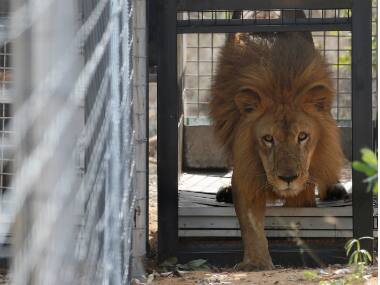In the span of just 10 days, there have been two tragic incidents involving zoos in Cincinnati and Santiago, Chile. First, two African lions in a Chilean zoo were shot when a man, attempting suicide, climbed into their cage. Then, Harambe – a 17-year-old male Western lowland gorilla – was killed to protect a four-year-old boy who fell into the moat in the primate’s enclosure. The Cincinnati and Chile incidents were strikingly reminiscent what happened at the Delhi zoo in 2014, when a youth entered the enclosure of a white Bengal tiger; it ended with the tiger mauling the man to death. These cases bring to the fore once again, a troubling question – should there be zoos at all in the modern world? “There is no easy black and white answer to this question,” says Zai Whitaker of the Madras Crocodile Bank. Whitaker’s sentiment seems to be echoed by the larger zoo community in India, which seems to be divided in its perception of zoos. [caption id=“attachment_2816726” align=“alignleft” width=“380”]  The gorilla Harambe. Image from Reuters[/caption] Zoo directors, private animal breeders and curators, as well as the Central Zoo Authority – an autonomous statutory body constituted under the Wildlife (Protection) Act — champion the importance of zoos, while wildlife biologists, non-governmental organisations and professionals working on zoos strongly suggest that unless these are managed scientifically and professionally to drastically improve their conditions, there is little reason for their continued existence – not only in India but world over. Maneka Gandhi, the union minister for Women and Child Development and staunch animal rights campaigner, strongly endorsed the idea in a recent statement. She said, “I am totally against zoos. They should be virtual. Or you can watch National Geographic and Discovery (channels). Zoos are hell on earth and should all be closed down. In any case, they are no longer places for amusement where people bring children. Most of them are for anti-social elements who simply tease these poor caged creatures till they die. There is no trained staff and mortality is high. Most of the animals are clinically depressed and want to die.” Experts Firstpost spoke to concurred. Ajith Kumar, scientist and director of the wildlife Masters’ program, Wildlife Conservation Society, tells us, “Generally animals go to zoos to die, births in captivity are accidental.” If such a grave situation has come about, it is due to a system stuck in archaic, Colonial ways of management. Zoos were initially places of entertainment and existed in the form of menageries. The opening of the London Zoological Gardens to public viewing in 1857 is credited as the earliest rendition of zoo as we know them today. So just to go to the zoo to see animals or for an outing is an old idea. Well-run modern zoos must be governed instead, by the principles of education, research and conservation. Global studies show more than 90 percent of the 6,000-8,000 zoos worldwide have made limited contributions to the conservation of species and captive breeding of animals. Zoos in India are still largely exhibition places. However, according to BC Choudhary, wildlife scientist and former professor, Wildlife Institute of India, blaming the condition of the zoos as an excuse to close them down is akin to letting a person suffering from ill health die. He suggests the focus should rather be on what can be done to improve the health of the zoos. Zoos, according to Choudhary, have a great opportunity to develop quality education programmes to impart knowledge to their over seven crore visitors annually (in India). These visitors can take on the role of watchdogs and help in improving the management of the zoos. Choudhary also points out that not everyone can afford to visit natural habitats to see animals in the wild; education programmes can help cultivate right consciousness towards animals. The onus is on zoos to develop programmes that cater to all age groups and to people from all backgrounds, creating an understanding of the environment such that the visitor returns regularly. [caption id=“attachment_2816732” align=“alignright” width=“380”]  Two African lions in a Chile zoo were shot after a man, attempting suicide, climbed into their enclosure.File photo, for representation only[/caption] Scientists also feel that an issue plaguing most zoos is that they come under the purview of the state governments and are managed by Indian Forest Service officers who may not have any zoo management background. Sanjar Molur, executive director, Zoo Outreach Organisation, points out that the same yardstick to evaluate the competence of officers serving in protected areas and territorial forests cannot be applied to officers serving in the zoos. He notes, “The zoos are currently run on management principles and not on scientific understanding.” Zoos offer an amazing opportunity to conduct research on captive animals themselves, their behaviour, diet etc that can be very useful for research in forests. India woefully lacks any data in this regard. The scientists argue that an independent body and professional cadre of managers who have an understanding and expertise in managing zoos should be installed. Qualified biologists must be recruited for handling and upkeep of animals catering to their nutrition, health and welfare. There should be different curators for different groups of animals. Ajith Kumar suggests that zoos across the country should form a network amongst themselves rather than be dependent on state forest departments. Zoos must be encouraged to develop their own goals and vision and have independent plans to conserve biodiversity from their own local regions. Further, zoo managers must be trained in scientific, ethical ways of maintaining their collections. Kumar recalls the director of Chandigarh zoo once boasting about how he had trained tigers – who are a solitary species – to live socially: In reality, the zoo had cramped 15 of them in one enclosure. Often, social animals like gorillas, elephants, monkeys are kept in solitary confinement while animals that grow to live on their own are kept in groups – sometimes to add to the value of the exhibit, at other times due to lack of space. There is a need for zoo enclosures and infrastructure to be designed by competent architects, keeping in mind the requirements of the occupants while not compromising visitor experience. “If zoos are used as a conduit for conservation of endangered species then it makes lot of sense. But if you are just running a zoo with bad exhibits and animals dying, then not so,” says Zai Whitaker. Zoos regularly claim their benefaction to conservation of endangered species as a mark of success. Shubhobroto Ghosh, author of Indian Zoo Inquiry, Dreaming In Calcutta and Channel Islands, questions zoos’ contribution to populations in the wild, pointing out that continuous breeding of animals that don’t have a future life in the wild is unnecessary and insufficient. It may be prudent to have viable breeding stock of certain endangered species in case a situation arises where introduction in the wild is necessary. Alternatively, zoos should be self-sufficient with no need to capture animals from the wild to be displayed as part of the zoo. Although world over, only a handful of species have been reintroduced from captivity into the wild, India’s record is abysmal. Only one success story stands out amongst a long list of critically endangered species – last week, six pygmy hogs, a critically endangered species found in the foothills of eastern Himalayas, were released in Barnadi Wildlife Sanctuary, Assam after 20 years. On 3 June 2016, a pair of Himalayan Griffons were released, culminating 10 years of captive breeding program after vulture numbers had plummeted by 90 per cent of their original numbers. Achievements like these are a few bright spots on an otherwise a terrible marksheet of animals bred in captivity. The CZA established in 1992 with a mandate to evaluate the management of animals kept in zoos has managed to implement few practices, from a time when there were no guidelines. But perhaps it is time to start implementing the best practices of zoo keeping from around the world, constantly challenging current philosophies adopted by zoos – if they are to be Noah’s Arks.
Cincinnati, Chile incidents show how zoos, which could be potential wildlife labs, are mere entertainment centers now
Advertisement
End of Article


)

)
)
)
)
)
)
)
)



